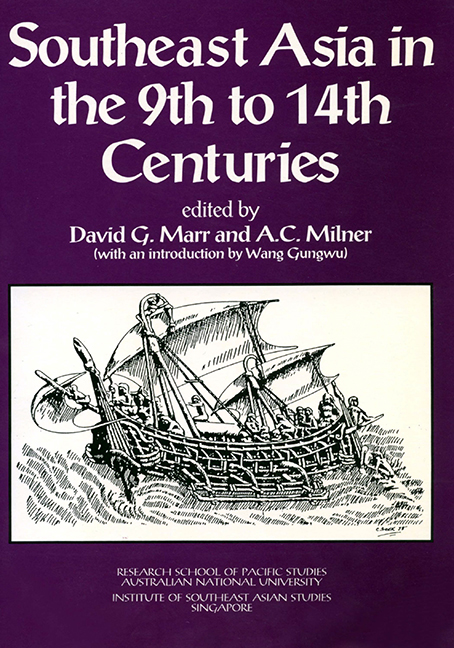Book contents
- Frontmatter
- Contents
- Contributors
- Preface
- Introduction
- 1 The Early and the Imperial Kingdom in Southeast Asian History
- 2 Hydraulic Works and South East Asian Polities
- 3 Some Notes on Relations between Central and Local Government in Ancient Java
- 4 Negara, Mandala, and Despotic State: Images of Early Java
- 5 Some Remarks on Early State Formation in Cambodia
- 6 “Elephants Can Actually Swim”: Contemporary Chinese Views of Late Ly Dai Viet
- 7 Authority and Legitimacy in 11th Century Vietnam
- 8 From Myth to History: Imagined Polities in 14th Century Vietnam
- 9 Shipshape Societies: Boat Symbolism and Political Systems in Insular Southeast Asia
- 10 Changing Perspectives in Island Southeast Asia
- 11 Political and Cultural Continuities at Dvaravati Sites
- 12 The True and the Corbel Arch in Mainland Southeast Asian Monumental Architecture
- 13 Vietnamese Ceramics and Cultural Identity: Evidence from the Ly and Tran Dynasties
- 14 Traditions, Acculturation, Renovation: The Evolutional Pattern of Vietnamese Culture
- 15 Symbolism of Kingship in Arakan
- 16 Buddhism in Champa
- 17 The Ordering of Generations: Change and Continuity in Old Javanese Kinship
- 18 Sources on Economic Activities in Khmer and Cham Lands
- 19 Narrative Bas-Reliefs at Candi Surawana
- 20 Possibilities for a Reading of the 1293-1357 Period in the Vietnamese Annals
- Index
- Miscellaneous Endmatter
20 - Possibilities for a Reading of the 1293-1357 Period in the Vietnamese Annals
Published online by Cambridge University Press: 21 October 2015
- Frontmatter
- Contents
- Contributors
- Preface
- Introduction
- 1 The Early and the Imperial Kingdom in Southeast Asian History
- 2 Hydraulic Works and South East Asian Polities
- 3 Some Notes on Relations between Central and Local Government in Ancient Java
- 4 Negara, Mandala, and Despotic State: Images of Early Java
- 5 Some Remarks on Early State Formation in Cambodia
- 6 “Elephants Can Actually Swim”: Contemporary Chinese Views of Late Ly Dai Viet
- 7 Authority and Legitimacy in 11th Century Vietnam
- 8 From Myth to History: Imagined Polities in 14th Century Vietnam
- 9 Shipshape Societies: Boat Symbolism and Political Systems in Insular Southeast Asia
- 10 Changing Perspectives in Island Southeast Asia
- 11 Political and Cultural Continuities at Dvaravati Sites
- 12 The True and the Corbel Arch in Mainland Southeast Asian Monumental Architecture
- 13 Vietnamese Ceramics and Cultural Identity: Evidence from the Ly and Tran Dynasties
- 14 Traditions, Acculturation, Renovation: The Evolutional Pattern of Vietnamese Culture
- 15 Symbolism of Kingship in Arakan
- 16 Buddhism in Champa
- 17 The Ordering of Generations: Change and Continuity in Old Javanese Kinship
- 18 Sources on Economic Activities in Khmer and Cham Lands
- 19 Narrative Bas-Reliefs at Candi Surawana
- 20 Possibilities for a Reading of the 1293-1357 Period in the Vietnamese Annals
- Index
- Miscellaneous Endmatter
Summary
The essay presents a reading of part of a Vietnamese historical text, and the reading is based on a few procedures derived from what is commonly known as structuralist criticism.[1] I am not interested in this form of criticism for theory's sake but only for its application in the context of historical study. The test of such an enterprise should always be whether anything arises worthy of the historian's consideration.
A simple definition of a text's structure is its presentation and language usage which give it a recognisable shape, and my reading approach will be to pay attention to the text's properties in order to describe them. The reading will be along and not between the lines, and the focus will be limited: the conventions that announce a genre, ways in which materials are organised, narrational devices, underlying systems of linguistic signification, and the effects these features have in contributing meaning to what is being read. The object of study is to throw some light on how a text is rendered intelligible and capable of making sense to its reader as a specimen of writing.
An exhaustive reading, which mine cannot claim to be, could account for every feature. From a structuralist perspective, all features may be fitting together, and to the extent to which they do, and how, may tell the reader something. I wish to insist, however, that optional readings are possible within this framework of enquiry, and I would welcome them.
The text in question is part of the chronological narrative known today as the Đai Viêt su ký toàn thu, the Vietnamese annals which purport to span Vietnamese history from earliest times to 1675. The text is written in Chinese, and its first printing was in 1697-1698.[2] I shall concentrate on only a fraction of the narrative: the years from 1293, not along after the last Mongol invasion, to 1357, when the Trân dynasty (1226-1400) was on the eve of its decline and eventual fall. These sixty-four years comprise five reign-periods, and the rulers' posthumous names by which they are known can be conveniently introduced here. The period begins immediately after Trân Ann-ton was appointed heir by his father, Trân Nhân-tôn. Nhân-tôn died in 1308, and in 1314 Anh-tôn appointed his son, Minn-tôn, as heir.
- Type
- Chapter
- Information
- Southeast Asia in the 9th to 14th Centuries , pp. 369 - 410Publisher: ISEAS–Yusof Ishak InstitutePrint publication year: 1986

